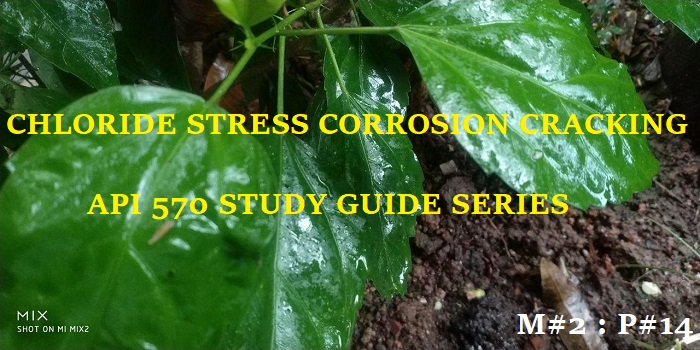API 570 STUDY GUIDE
MODULE 2 : PART 14
CHLORIDE STRESS CORROSION CRACKING
Description of Damage
- Surface initiated cracking
- cracking of 300 Series SS and some nickel base alloys
- Combined action
- Tensile stress, temperature, an aqueous chloride environment and the presence of dissolved oxygen
Affected Materials
- All 300 Series SS are highly susceptible.
- Duplex stainless steels are more resistant.
- Nickel base alloys are highly resistant, but not immune.
Critical Factors
Read in this manner,
- Six factors affect Cl-SCC
- Cl Content [Read Clause ‘c’ & ‘d’ under the heading critical factors]
- pH [Read Clause ‘f’ under the heading critical factors]
- Temperature [Read Clause ‘b’, ‘e’ & ‘g’ under the heading critical factors]
- Stress [Read Clause ‘h’ under the heading critical factors]
- Presence of O2 [Read Clause ‘i’ under the heading critical factors]
- Material alloy composition [Read Clause ‘j’, ‘k’ & ‘l’ under the heading critical factors]
- No Lower limit for Cl content
- For pH value >2, usually Cl-SCC occurs
- In Lower pH, Uniform corrosion occurs and not Cl-SCC
- SCC decreases towards alkaline pH region
- Stress can be applied or residual.
- Cold worked components (eg: Expansion bellows) are susceptible
- Nickel content is a major factor.
- 8% to 12% Ni materials are more more to Cl-SCC
- Ni>35% are highly resistant and Ni>45% are immune
- 400 Series SS are not susceptible
- CS and Low alloy steels are susceptible
- Dissolved O2 accelerates Cl-SCC. But limit of dissolved O2 is not identified.
- Temperature >60 Deg.C are more prone to Cl-SCC
- Wet-dry conditons of steam and water are susceptible to Cl-SCC
- If level of Cl and Temperature increases chances for cracking increases.
Affected Units or Equipment
Piping
- 300 Series SS process lines
- Drains in hydro processing units are susceptible to cracking during startup/shutdown if not properly purged
- boiler drain lines
- External Cl–SCC on insulated surfaces when insulation gets wet
- Bellows and instrument tubing, particularly those associated with hydrogen recycle streams contaminated with chlorides
- 300 Series SS process equipment
- water-cooled condensers
- process side of crude tower overhead condensers
- External Cl–SCC on insulated surfaces when insulation gets wet
Appearance or Morphology of Damage
The material usually shows no visible signs of corrosion.
Surface breaking cracks can occur from the process side or
externally under insulation
Metallography of cracked samples typically shows branched
transgranular cracks
Fracture surfaces often have a brittle appearance.
Characteristic stress corrosion cracks have many branches and may be visually detectable by a craze-cracked appearance of the surface
Corrosion-resistant nickel-based alloys are also
susceptible to cracking under severe conditions
Sometimes intergranular cracking of sensitized 300 Series
SS may also be seen
Welds in 300 Series SS usually contain some ferrite, producing a duplex structure that is usually more resistant to Cl–SCC
Prevention / Mitigation
Avoid or reduce the chloride content.
During
construction phase,
- Use Cl-SCC resistant materials.
- By design avoid regions that may cause chlorides to concentrate or deposit.
- During hydrotest, use low chloride water and dry out the water as quickly and thoroughly.
- Stress relief of 300 series SS after fabrication to reduce residual stress.
Insulation related: Apply proper coatings under insulation and another way is to use low chloride coatings.
Stress relief of 300 series of SS may cause,
- increasing susceptibility to polythionic SCC
- possible distortion problems
- potential reheat cracking
Inspection and Monitoring
Cl-SCC is surface initiated cracking. So Surface NDE methods are used for detection.
Visual Inspection
In
some cases, visual inspection reveals cracks.
Penetrant Testing (PT)
PT is one of the preferred methods for Cl-SCC. But extremely fine cracks cannot be found by PT. Special surface preparation methods, including polishing or high-pressure water blast, may be required in some cases, especially in high pressure services are done before PT.
Eddy
Current Inspection
condenser
tubes as well as piping and pressure vessels eddy current inspections are used.
Phase Analysis EC technique is one of the other preferred method for crack detection other than PT
UT
UT can also be done for detection
RT
As these are surface cracks, RT will not be sufficiently sensitive.
Related Mechanisms
Caustic SCC
Polythionic acid SCC
FROM API 570
QUESTIONS
This blog is not a replacement for the training provided by authorized partners/experienced institutions nor this blog guarantee success in API exams. This blog is the outcome of the approach followed by the author for the preparation of API exams.

Super sir good notes
ReplyDeleteThank you for reading my blog. The updations on the website will be published in the facebook page https://www.facebook.com/MechConstEngineer
Delete